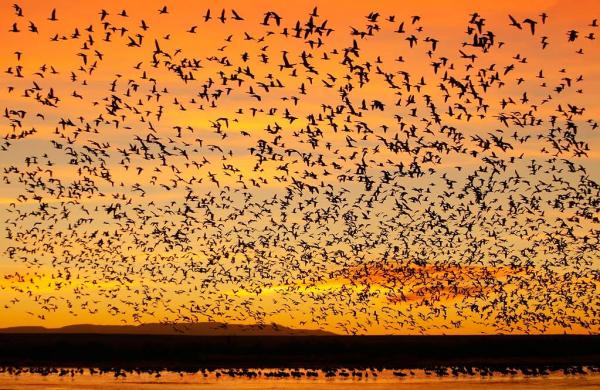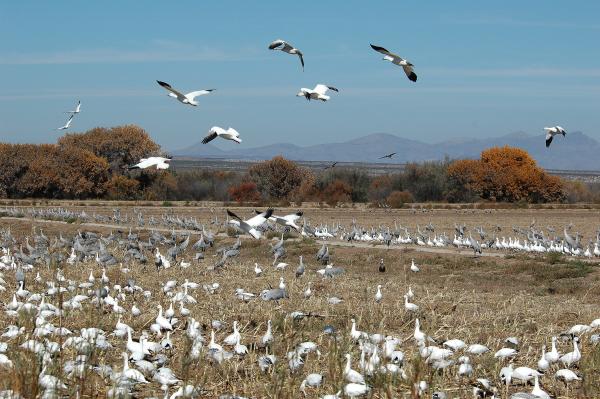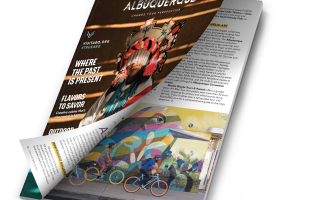Visit Albuquerque prohibits users from downloading images from our website.
Please use our media library for downloadable images and usage rights.
See More in this Section:
Birding in Albuquerque
View some of the more than 500 species in New Mexico
Depending on the time of year, Albuquerque offers abundant opportunities for birding enthusiasts to check several dozen species off their life lists in just one trip.
“As bird diversity is equivalent with habitat diversity, it is not surprising that Albuquerque, New Mexico ranks number four in bird diversity in the United States,” wrote David Mehlman, former director of the Nature Conservancy’s national Migratory Bird Program. “From the Rio Grande River Valley at 5,000 feet elevation to the Sandia Mountains at 10,678 feet elevation, both amateur and more experienced avian enthusiasts, will discover a fascinating range of bird species.”
New Mexico’s state bird, the roadrunner, can be found throughout the city; Cooper’s hawks can be seen year-round; and every birder knows that the Rio Grande is a migratory flyway for sandhill cranes each fall and spring. But did you know that our Sandia Mountains are one of the best places to view three different species of rosy finches, and that the area has one of the country’s largest populations of pinyon jays, which nest among our piñon and juniper trees? These colorful residents make Albuquerque “the land of the finch and the home of the jay.”
Accessibility and the diversity of migrating and native New Mexico birds are the primary reasons to experience birding in Albuquerque. Below are recommendations for some of the top birding spots in and around Albuquerque. While visiting, be sure to also explore the city’s distinctive New Mexican cuisine, rich Native American and Hispanic cultural heritage, and plentiful opportunities for outdoor recreation.
Rio Grande Nature Center

Although small in size, the Rio Grande Nature Center State Park is a top destination for birders living in or visiting the Albuquerque area. Over 300 species of bird can be observed over the course of a year. The entertaining Greater Roadrunners (New Mexico’s state bird!) are the most sought-after resident species and are easy to spot. Many migrant species stop over during their journeys along the Rio Grande; they may have traversed from wintering grounds as far south as Argentina or summer homes as far north as Siberia. Sandhill Cranes and a large variety of waterfowl liven up the tranquil winter season. Grosbeaks, tanagers, orioles, hummingbirds and warblers offer serenades and colorful views during nesting season. Birds are drawn to the Park’s ponds, wetlands and feeding stations which can be viewed from both outdoor locations and from inside the Visitor Center. A wooded half-mile trail leads visitors from the parking lot through the bosque or riverside forest out to the Rio Grande and back. Expert guides lead bird walks on Saturdays or Sundays year-round beginning at 8:30 a.m., or you can explore on your own. For more information about the birds observed at RGNCSP, visit eBird.org.
Sandia Crest

Photo Credit: Carl Bendorf
The Sandia Mountains are one of the best places on the continent to view three species of rosy finches (black, gray-crowned and brown-capped) during their non-breeding season, from early winter to early spring. Ken and Mary Lou Schneider, who served as coordinators of the Rosy Finch project at Sandia Crest for many years, have aptly named this remarkable phenomenon "Rosy Tourism." As Ken wrote in Birder’s World Magazine, “Many birders’ life lists have no marks in the checkboxes next to the three rosy finch species. These New Mexico birds' breeding ranges are largely non-contiguous and often in hard-to-reach places. Finding all three species on their nesting grounds generally requires three separate journeys, some arduous mountain hiking, and a bit of luck.” To see the rosy finches in Albuquerque between December and March, visitors need only drive 13 miles on a well-tended road to Sandia Crest. For more detailed information on rosy tourism, go to www.rosyfinch.com.
Tingley Beach

The ABQ BioPark's Tingley Beach is a great place to watch wild waterfowl. Ducks of many species gather at the fishing ponds. Take a walk into the bosque to spot other species including owls, hawks and woodpeckers. Two ponds farther into the bosque feature photography blinds to allow closer access to birds that may be congregating there.
Open Space Visitor Center

Photo Credit: Facebook
The Open Space Visitor Center is a great place to view migrating birds traveling through New Mexico, particularly in the fall and winter. The Open Space Visitor Center is especially known for spotting sandhill cranes. These birds stop in Albuquerque on their migration during the fall. View the Sandhill Cranes and other bird species with a beautiful backdrop of the Sandia Mountains. The Open Space Visitor Center has indoor and outdoor viewing areas to watch birds year-round.
Bosque del Apache National Wildlife Refuge

Just a short drive away from Albuquerque, Bosque del Apache National Wildlife Refuge is a must-see for birders. Hundreds of species have been spotted here. The more than 57,000-acre refuge has over 30,000 acres of designated wilderness. Bosque del Apache acts as a stopover site for migrating waterfowl. A number of birds spend the winter at Bosque del Apache, including cranes, geese and ducks. For more information about the birds observed at Bosque del Apache, visit eBird.org.
Valle de Oro National Wildlife Refuge

Photo Credit: Dick Thompson
Valle de Oro National Wildlife Refuge is located in South Albuquerque and features many species of birds. Popular with both nesting and migrating species, keep your eyes peeled for American kestrels, egrets, cranes and roadrunners. Built on a former dairy farm, Valle de Oro has 570 acres of land for you to explore and spot as many birds as you can.
Birding Map
Albuquerque has earned designation from the U.S. Fish and Wildlife Service as an Urban Conservation Treaty City for migratory birds. This designation recognizes the city’s efforts to conserve habitat for birds that live in and migrate through the Albuquerque area. The Albuquerque Urban Bird Coalition’s birding site map identifies locations in and around the city to observe migratory and year-round birds.
Birding Events
Bosque Del Apache Festival of The Cranes in November
The Festival of the Cranes at the Bosque Del Apache National Wildlife Refuge celebrates the arrival of many thousands of cranes, geese, ducks and other migratory birds. www.friendsofthebosque.org/crane/.
Looking For More Albuquerque Highlights?
Coupons & Discounts
Save money on Albuquerque and New Mexico restaurants, shopping, hotels, attractions, theater and more. Create... More
Sports & Outdoor
The city of Albuquerque sits at a mile above sea level (5,000-6,000 ft. elevation) and has a high-desert... More
Family Fun & Games
Albuquerque has fun for all ages, see our family fun page to learn more! More







